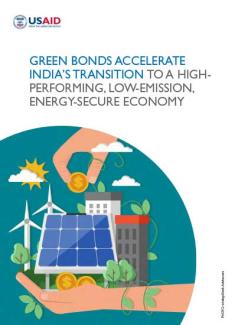Green Bonds in India
Scaling Up Renewable Energy (SURE)
Report –
India faced a massive capital investment challenge and needed affordable, long-term financing to scale up renewable energy. USAID supported Green Bonds as a solution.
Accelerating the Transition to a High-Performing, Low-Emission, Energy-Secure Economy
Renewable energy has the potential to reduce India’s greenhouse gas emissions, provide access to electricity for its more than one billion citizens, reduce water and air pollution, and meet the country’s growing energy needs. As of 2020, India has auctioned 69 GW of renewable energy capacity, but the potential exists for much more. Estimates indicate that only three percent of India’s renewable resources have been harnessed.
Financing for Renewable Energy
Committed to scaling up renewable energy, the Government of India set goals of adding 175 GW by 2022 and 450 GW by 2030. To meet these targets, India’s Ministry of New and Renewable Energy (MNRE) estimates that additional investments of $380 billion will be required.
Access to scalable, long-term, low-cost debt capital is critical to the growth of the renewable energy sector and for India to reach its renewable energy goals. From 2013 to 2017, the U.S. Agency for International Development (USAID) partnered with the MNRE to explore innovative financing mechanisms that can overcome the market’s financial limitations.
USAID Support
Defining Green Bonds: Green bonds are used to finance environmentally friendly projects. A government or business, including banks, issues a bond to borrow long-term, low-cost debt capital from institutional investors, retail investors, governments, treasuries, and central banks. The issuer pays investors a specific rate of interest during the life of the bond and repays the principal after a set time period. This large amount of upfront capital with long-term manageable repayments matches the needs of renewable energy projects.
USAID supported green bonds as a potential financing solution to address the investment gap in the Indian market. Once the MNRE decided to move forward, USAID helped build the capacity of local financial institutions, which were critical to green bonds’ successful issuance, by introducing Indian project developers and financiers to institutional investors interested in backing their projects. After the initial groundwork in 2014, India issued its first green bond in 2015.
USAID’s efforts to scale green bonds support the Asia Enhancing Development and Growth through Energy (Asia EDGE) initiative and the U.S.–India Strategic Energy Partnership, which advance both countries’ comprehensive energy strategies and shared commitment to environmental responsibility. The partnership aims to enhance energy security, expand innovation across respective energy sectors, deepen bilateral strategic alignment, and increase industry and stakeholder engagement.
Lasting Impact
Prior to 2015, there were no large-scale issuances. Today, India has increased capital for renewable energy projects and has become the world’s second-largest market for green bonds, with $28.2 billion worth of bonds issued.
Since USAID first introduced green bonds and helped issue the first bonds through the Indian Renewable Energy Development Agency, the private sector has been the most active, issuing around two-thirds of all green bonds. Specifically, independent power producers who steer the deployment of renewables in India have led the way on green bonds.

